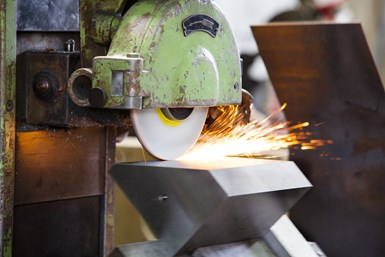On its surface, grinding seems simple: a machine takes a rotating tool (usually a wheel) with abrasive grains and applies it to a workpiece’s surface to remove material. Each grain is its own miniature cutting tool, and as grains dull, they tear from the tool and make new, sharp grains prominent.
But there are many variations, approaches and considerations for this type of machining, each of which is particularly effective for certain applications with certain materials.
Principles of Grinding
In all forms of grinding, three different interactions occur between the abrasive and the machined material. Cutting occurs where the abrasive grain is sufficiently exposed to penetrate the workpiece material and curl a chip, and sufficient clearance exists between the grain, bond and workpiece to flush the chip with coolant or throw it away by wheel action. Plowing takes place when the grain is unable to get enough penetration to lift a chip, instead pushing the material ahead of the abrasive edge. Sliding happens when a lack of cut depth, insufficient clearance or a grit staying on the wheel after dulling results in rubbing or creating slide marks on the workpiece surface. Grinding process control balances these three interactions to achieve the desired parameters.
These interactions feed into three major commercial grinding processes: rough grinding, precision grinding and ultra-precision grinding. Rough grinding maximizes the metal removed at the cost of surface finish. It primarily sees use in cutting off billets, grinding weld beads smooth and snagging gates and risers from castings. Additional surface finishing passes typically take place afterward — in particular, a “spark-out” pass relieves some of the stress on the machine tool and uses plowing to impart a better surface finish and size tolerance. Precision grinding is a middle-ground between metal removal and part size control, and serves as the basis for creep feed grinding, slot grinding and high-efficiency deep grinding. In ultra-precision grinding, little to no actual cutting occurs, but sliding action from very fine grains rubs the workpiece surface to a high finish. Most surface finishing processes, such as lapping and polishing, are examples of this type of grinding.
Read more: Machining 101: What is Grinding?





